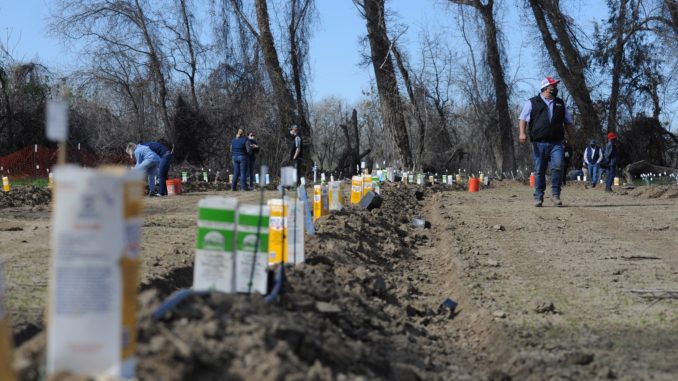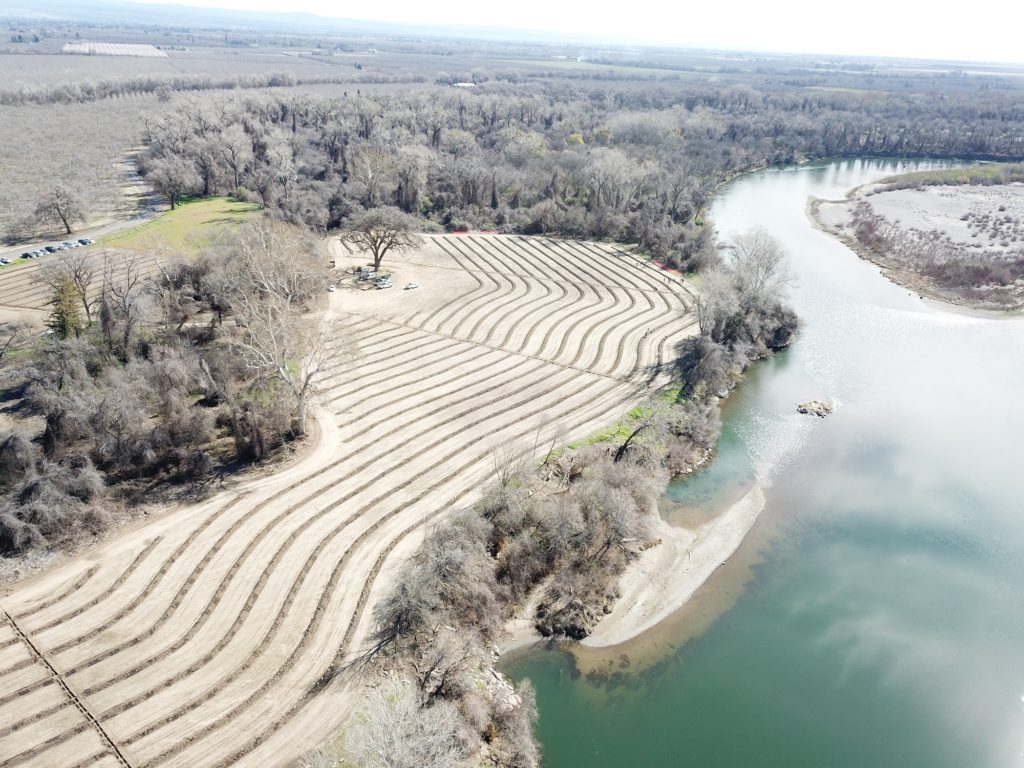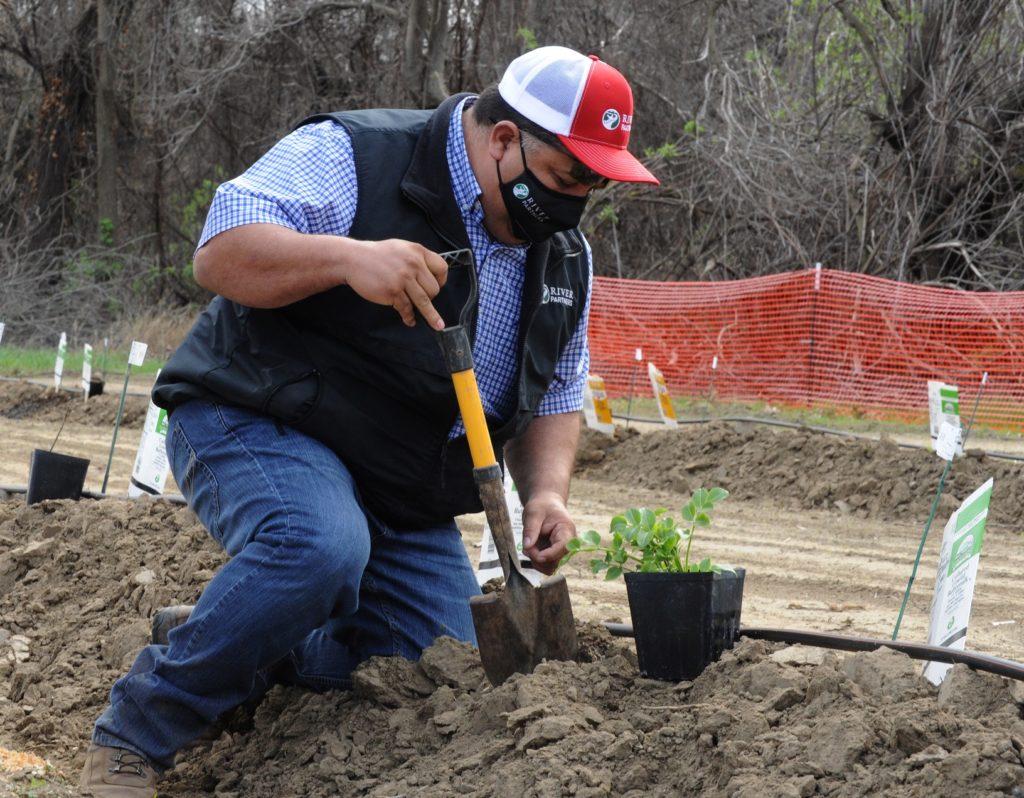
As winter turns to spring and North State residents seek respite from coronavirus confinement, those who visit Bidwell-Sacramento River State Park will find new signs of life during their riparian escape.
Two dozen workers from four agencies congregated near the Pine Creek Access Unit on Thursday morning (Feb. 25) for a restoration project that, when complete, will return 24 acres of riverside land to its natural state. They planted native trees and bushes, installed irrigation and contoured the site with features such as berms.
This is just one such initiative to restore local wetlands. River Partners, a Chico-based nonprofit, is coordinating five projects in the Sacramento Valley, including habitat work in 1,400 acres of Hamilton City levee setbacks.
River Partners President Julie Rentner called the Pine Creek Access project “relatively small in the scheme of things, but it’s part of a much larger effort of many, many partners working in this area over the last two decades to really turn the tide on the decline that’s causing resource conflict in California.”
Rentner, who oversaw River Partners projects in the San Joaquin Valley before coming to Chico in 2019, told the CN&R that the range of benefits from this restoration—to plant life, fish, birds, humans—make it “a beautiful example of nature-based solutions. That’s a topic we hear our state and federal resource leaders talking about lately, is stacking really important environmental solutions in one project site.”
That’s what drew so many different groups together Thursday. Joining River Partners were workers from California State Parks and the Butte County Resource Conservation District, the project’s cosponsors, along with volunteers from the Altacal Audubon Society, who have expertise in bird habitats.

Once fully restored, in approximately three years, the acreage will reestablish as a forest of oaks and other riparian growth, culminating a project 20 years in germination. The parcel crosses the historic Indian Fishery—along with boosting salmon and other aquatic species, Rentner said the habitat will attract birds, pollinators and land animals; sequester greenhouse gases, and broaden outdoor experiences for visitors.
Those mesh with priorities of the park service, according to Ryan Martin, resources program manager of the Northern Buttes District for California State Parks. The department bought the property—a walnut orchard in decline—back in 2004 with an eye toward restoration. Funding finally came in 2019.
“Some of the overall goals with riparian habitat is to keep [natural] these large, connected patches of habitat which have been removed from the Sacramento watershed,” he told the CN&R. “It gets back to all this other work that’s going on [such as] the Hamilton City levee project work that’s across the river.”
Martin added that one of the next projects under consideration is another declining walnut orchard, 17 acres, across the Sacramento River on the Glenn County side by the Irvine Finch boat ramp.
“We own it, but we’re not necessarily farmers,” he said of the park service, “so we want to restore that and put it back to natural habitat.”
Collective efforts
Established in 1998, River Partners has a track record of watershed restoration—with, as its name suggests, partners. It receives the bulk of its funding from government agencies and grants. Its primary partner for the Hamilton City levee project is the Army Corps of Engineers; they completed the first phase in December and will start the final phase next year.
Coronavirus hasn’t slowed River Partners; ironically, the opposite. With its work outdoors and workers already distanced, plus its funds previously approved, the organization decided to amp up hiring. Statewide, River Partners employed 75 full-timers and 35 seasonal workers in 2020, investing 98 percent of its $17 million revenue directly into projects.

“We leaned into getting a whole bunch of work done,” Rentner said. “We looked at every nook and cranny and said, ‘Where is there work to be done?’”
The result: 2,120 acres restored, a high-water mark for River Partners.
Along with the Pine Creek Access and Hamilton City levee projects, River Partners is working at the Willow Bend Preserve, south of Princeton, to reconnect 150 acres of flood plain to bolster salmon populations. Partners there include the National Marine Fisheries Service, California Natural Resource Conservation Service and California Department of Fish and Wildlife. All told, the Sacramento River work extends from Red Bluff to Colusa.
Thursday at the Pine Creek Access site, workers planted what Martin described as “a mosaic—a pretty good planting palette” of native species. As a biologist and environmental scientist with an emphasis in ornithology, he’s especially keen on birds; thus, he’s eager for the oaks, sycamores and willows to mature and serve as nesting places.
Martin also anticipates human visitors enjoying the restored space.
“It’s about the public experience,” he said. “Given the current times, where we’re at with COVID, right now is a time when they’re saying we need to be outdoors. As humans, we need to be outdoors, in nature. It’s really beneficial in terms of our overall health.
“To me, this project is great. It’s taking a landscape, restoring it back to a more natural state, and at the end of the project we’re going to have this available and open to the public to picnic with their family and friends, or take their kids fishing, or go down and skip rocks in the river.
“There’s just a lot of ways they can be outdoors and enjoy this landscape once it’s completed.”

Be the first to comment